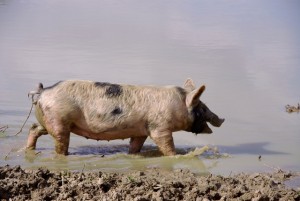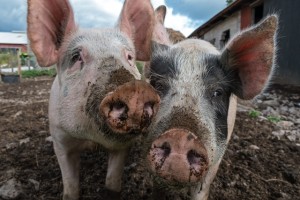Pig Diseases
Erysipelas in Pigs
Also known as: Erysipelothrix rhusiopathiae

Erysipelothrix rhusiopathiae bacteria can survive for long periods in the environment and in water. Water systems can become infected with the bacteria and be a source of disease.
The bacteria are widespread in the environment and stress, husbandry methods, and intercurrent disease are key risk factors. Establishment of infection occurs through regular contamination of damaged skin resulting from poorly constructed floors and cohabitation with other carrier species such as birds.
Infection is characterised by acute or sub-acute septicaemia and chronic lesions, usually arthritis or valvular endocarditis (heart condition with lesions in the heart valves). The speed of multiplication and the level of immunity in the pig determines the clinical symptoms.
The most typical symptoms of acute septicaemia are high fever and distinctive skin lesions (“diamonds”). These lesions may appear as early as 2 or 3 days after infection, however they do not appear in every clinical case, and their presence is only indicative of erysipelas not conclusive. The lesions vary in size, from small 1–2 cm diamonds to 4–5 cm blotches, and colour, from light pink and purple to an intensely red area with a white centre, appearing like targets on the skin. If the animal survives, typical lesions may disappear in about a 4–7 days if not complicated (Colavita et al., 2006).
Chronic arthritis is manifested in lameness and swollen joints, most commonly the hock, stifle elbow and carpal joints (Colavita et al., 2006). Currently, chronic arthritis is the most common form of the disease in the UK. Infertility can occur in affected sows (Martinez et al., 2008), especially if they have clinical signs around mating time. Infections may cause abortion or influence stillbirth rate and litter size (Gertenbach and Bilkei, 2002). Chronic heart valves lesions can cause unexpected mortality.
According to the EU regulation 854/2004 for meat inspection, enforced in January 2006, any swine carcase affected by erysipelas must be destroyed and when pigs show erysipelas during ante-mortem inspection, the slaughtering must be deferred, although the length of this period is not specified (Colavita et al., 2006). Colavita et al (2006) suggest that for cutaneous erysipelas this period should be at least 15 days from disappearance of typical lesions for cutaneous erysipelas, in order to guarantee a good level of safety of the meat and to reduce the hazard of occupational disease for veterinarians, abattoir workers and meat processors.
Control and Prevention of Erysipelas

Erysipelothrix rhusiopathiae, the bacteria that causes swine erysipelas, is present on all if not most pig farms. A monitoring system should be in place in order to detect any cases should they appear.
Pigs, both carriers and acutely infected animals, are considered the main reservoir for Erysipelothrix rhusiopathiae in a herd. Soil or faeces contamination or wildlife reservoir are considered insignificant as sources of infection (Wood and Henderson, 2013). The pathogen has the ability to persist in the environment for long periods and can survive marine conditions (Brooke and Riley, 1999).
Suckling piglets of an immune sow are usually resistant to the disease until the maternal immunity wanes. Similarly, older sows tend to be immune. There does not appear to be any genetic resistance to erysipelas. Other, concurrent infections, such as parasitic infestations or mycotoxins, or nutritional or environmental/climatic changes have all been suggested as predisposing factors for an erysipelas outbreak (Wood and Henderson, 2013), although the main risk factor for an outbreak is the introduction of a new animal into the herd.
Swine Erysipelas Vaccines
Killed and inactivated vaccines are available and their use is advocated by some (Redhead et al., 1998; Wood and Henderson, 2013), while others express doubts about the efficacy of the vaccine (Chen et al., 1998). It is generally accepted that the vaccines do not have much or any effect on the development of chronic erysipelas arthritis, and it has been suggested that the vaccination actually enhances the development of chronic erysipelas arthritis (Wood and Henderson, 2013).
However vaccination is commonly used in the UK especially in the breeding herd. Examples are Porcilis Ery and Ery + Parvo, Eryseng Parvo (Hipra). Autogenous vaccine is also an option if it can be proven that the commercial vaccinations are unsuitable for managing the on farm situation. Erysipelas vaccination needs to be repeated every 4-6 months. It is appropriate for sows and gilts throughout their lifetime.
Vaccines give a protective immunity for 4-6 months. If a vaccination programme is used, gilts should be vaccinated on arrival in the unit and subsequently at every weaning. Vaccination can also be used for growing animals in a high challenge situation.
Sows often get vaccinated as they are moved into the farrowing area and there is a risk that boars get forgotten for booster vaccinations and can then become infertile following infection for 6 to 8 weeks (A.Bassett, pers.comm).
The use of ginseng (the dry extract prepared from the Panax ginseng C.A. Mayer-root) as a co- adjuvant has been shown to improve the antibody response of vaccination. Ginseng contains immunomodulators named ginsenosides, which in the pig enhance the antibody response to viral and bacterial antigens (Rivera et al., 2003).
Treating Erysipelas
Antibiotic therapy is effective if treated early enough. Erysipelothrix rhusiopathiae is very sensitive to penicillin (a narrow spectrum antibiotic) and this should be used early in an outbreak and under veterinary prescription. Long-acting penicillin is routinely used.
If an unvaccinated herd experiences several outbreaks, a vaccination programme should be considered.
Erysipelas and Welfare
Affected animals should be diagnosed and treated as soon as possible with penicillin to avoid suffering and chronic infections.
Good Practice Based on Current Knowledge
As part of the overall health herd plan, the erysipelas situation on every farm should be assessed based on historic records/abattoir returns or by starting to collect this information. Based on the data, a policy to control erysipelas should be established and can follow one of the two scenarios:
- No vaccination
If the farm chooses not to vaccinate, a monitoring system should be put in place to assess arthritis clinically and post mortem at the abattoir in order to detect chronic erysipelas arthritis if this appears. Routine blood sampling to check levels of immunity is also recommended. A policy of immediate treatment with penicillin at the first sight of clinical condition should also be implemented. If an unvaccinated farm experiences repeated outbreaks, a vaccination policy should be implemented - Continuous vaccination
If the farm chooses to vaccinate, all gilts should be vaccinated on arrival or when introduced to the acclimatisation paddocks. The vaccination needs to be repeated at each weaning throughout the sow’s life. Many breeding companies vaccinate gilts prior to delivery, and therefore details of what vaccinations have been given should be sought. Ensure boars are also fully vaccinated.


 American English
American English

Comments are closed.